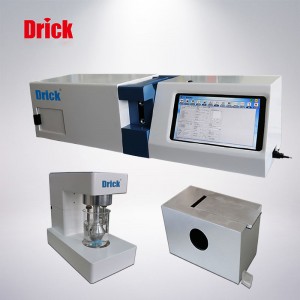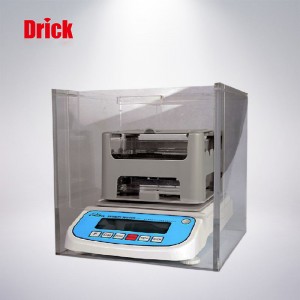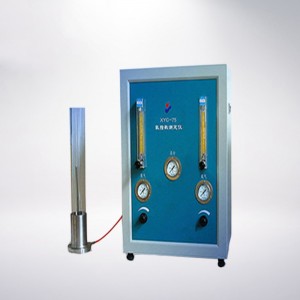DRK-W Series Laser Particle Size Analyzer
The high quality of the DRK-W series laser particle size analyzer and the wide range of tested samples make it widely used in many fields such as laboratory experimental research and industrial production quality control. For example: materials, chemicals, pharmaceuticals, fine ceramics, building materials, petroleum, electric power, metallurgy, food, cosmetics, polymers, paints, coatings, carbon black, kaolin, oxides, carbonates, metal powders, refractory materials, additives, etc. Use particulate matter as production raw materials, products, intermediates, etc.
With the increasing progress and development of science and technology, more and more fine particles have appeared in many sectors of the national economy, such as energy, power, machinery, medicine, chemical industry, light industry, metallurgy, building materials and other industries. Technical problems have yet to be resolved, and the measurement of particle size is one of the most basic and important aspects. In many cases, the size of the particle size not only directly affects the performance and quality of the product, but also has a significant relationship with the optimization of the process, the reduction of energy consumption, and the reduction of environmental pollution. In recent years, various new particle materials closely related to high-tech, national defense industry, military science, etc., especially the advent and utilization of ultrafine nanoparticles, have put forward new and higher requirements for the measurement of particle size. Not only requires fast and automated data processing, but also requires reliable and richer data and more useful information to meet the needs of scientific research and industrial quality control applications. TS-W series laser particle size analyzer is the latest generation of laser particle size analyzer carefully developed to meet the above new requirements of users. The instrument integrates the application of advanced laser technology, semiconductor technology, optoelectronic technology, microelectronic technology and computer technology, and integrates light, machine, electricity, and computer. The outstanding advantages of particle size measurement technology based on light scattering theory are gradually Instead of some traditional conventional measurement methods, it will surely become a new generation of particle size measuring instruments. And it plays an increasingly important role in the analysis of particle size distribution in the field of scientific research and industrial quality control.
The high quality of the DRK-W series laser particle size analyzer and the wide range of tested samples make it widely used in many fields such as laboratory experimental research and industrial production quality control. For example: materials, chemicals, pharmaceuticals, fine ceramics, building materials, petroleum, electric power, metallurgy, food, cosmetics, polymers, paints, coatings, carbon black, kaolin, oxides, carbonates, metal powders, refractory materials, additives, etc. Use particulate matter as raw materials, products, intermediates, etc.
Technical Features:
1. Unique semiconductor refrigeration thermostatically controlled green solid-state laser as the light source, with short wavelength, small size, stable work and long life;
2. Uniquely designed large-diameter light target to ensure a large measurement range, no need to change the lens or move the sample cell within the full measurement range of 0.1-1000 microns;
3. Collecting the results of years of research, the perfect application of Michaelis theory;
4. Unique inversion algorithm to ensure the accuracy of particle measurement;
5. USB interface, instrument and computer integration, embedded 10.8-inch industrial-grade computer, keyboard, mouse, U disk can be connected
6. Circulating sample pool or fixed sample pool can be selected during measurement, and the two can be replaced as needed;
7. Modular design of the sample cell, different test modes can be realized by changing the module; the circulating sample cell has a built-in ultrasonic dispersion device, which can effectively disperse agglomerated particles
8. The sample measurement can be fully automated. In addition to adding samples, as long as the distilled water inlet pipe and the drain pipe are connected, the water inlet, measurement, drainage, cleaning, and activation of the ultrasonic dispersion device can be fully automated, and manual measurement menus are also provided;
9. The software is personalized, providing many functions such as measurement wizard, which is convenient for users to operate;
10. The measurement result output data is rich, stored in the database, and can be called and analyzed with any parameters, such as the operator’s name, sample name, date, time, etc., to realize data sharing with other software;
11. The instrument is beautiful in appearance, small in size and light in weight;
12. The measurement accuracy is high, the repeatability is good, and the measurement time is short;
13. The software provides the refractive index of many substances for users to choose to meet the user’s requirements for finding the refractive index of the measured particle;
14. Considering the confidentiality requirements of test results, only authorized operators can enter the corresponding database to read data and process;
15. This instrument meets but is not limited to the following standards:
ISO 13320-2009 G/BT 19077.1-2008 Particle size analysis Laser diffraction method
Technical Parameter:
| Model | DRK-W1 | DRK-W2 | DRK-W3 | DRK-W4 |
| Theoretical basis | Mie scattering theory | |||
| Particle size measurement range | 0.1-200um | 0.1-400um | 0.1-600um | 0.1-1000um |
| Light Source | Semiconductor refrigeration constant temperature control red light solid laser light source, wavelength 635nm | |||
| Repeatability error | <1% (standard D50 deviation) | |||
| Measurement error | <1% (standard D50 deviation, using national standard particle inspection) | |||
| Detector | 32 or 48 channel silicon photodiode | |||
| Sample cell | Fixed sample pool, circulating sample pool (built-in ultrasonic dispersion device) | |||
| Measurement analysis time | Less than 1 minute under normal conditions (from the beginning of the measurement to the display of the analysis results) | |||
| Output content | Volume and quantity differential distribution and cumulative distribution tables and graphs; various statistical average diameters; operator information; experimental sample information, dispersion medium information, etc. | |||
| Display method | Built-in 10.8-inch industrial-grade computer, which can be connected to keyboard, mouse, U disk | |||
| Computer system | WIN 10 system, 30GB hard disk capacity, 2GB system memory | |||
| power supply | 220V, 50 Hz | |||
Working Conditions:
1. Indoor temperature: 15℃-35℃
2. Relative temperature: no more than 85% (no condensation)
3. It is recommended to use AC power supply 1KV without strong magnetic field interference.
4. Due to the measurement in the micron range, the instrument should be placed on a sturdy, reliable, vibration-free workbench, and the measurement should be performed under low dust conditions.
5. The instrument should not be placed in places exposed to direct sunlight, strong wind, or large temperature changes.
6. The equipment must be grounded to ensure safety and high accuracy.
7. The room should be clean, dust-proof, and non-corrosive.
Products categories
-

Phone
-

E-mail
-

Whatsapp
-

Top








